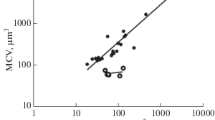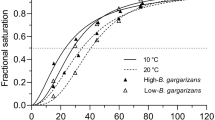Abstract
Hematocrit levels in highland (3900–4500 m) AKODON (4 species) showed no change following a month at sea level, but showed a reduction of about 50 ml/1 after an additional 1–2 months. Feral MUS established at 4500 m had more cells(570 vs.470 ml/l) than those from sea level; about half this advantage was lost after a week at sea level. Highland species or races showed no consistent advantage in erythrocyte level over lowland species. The lowland PHYLLOTIS DARWINII LIMATUS actually had a higher hematocrit than any of the highland PHYLLOTIS. Mean cell hemoglobin concentrations ranged from 28 to 33 g/100 ml in rodents, and to 42 g/100 ml in the alpaca.Mean cell volumes ranged from 44 to 65Μ 3 in rodents, and were 25–26Μ3 for the alpaca and vicŨna. The cell hemoglobin mass varied from 13 to 18 g in rodents and was 11.5Μg in the alpaca and vicuña. None of these values for rodents appear remarkable.
Zusammenfassung
Die HÄmatokrit-Werte von 4 Arten Hochland-AKODON (3900–4500 m) zeigten nach einem Monat Aufenthalt der Tiere auf Meereshöhe keine VerÄnderung; nach 2–3 Monaten waren die Werte 50 ml/l niedriger als der Vorwert. Wilde MUS in 4500 m Höhe hatten 570 ml und wilde MUS auf Meereshöhe 470 ml Erythrozyten/1 Blut. Wurden die Tiere aus der Höhe ins Tal gebracht, verschwand die HÄlfte des Unterschiedes innerhalb einer Woche. Die Erythrozyten-Werte von Hochland-Arten und -Rassen zeigten keine übereinstimmende überlegenheit über die von Tiefland-Arten. Tiefland PHYLLOTIS DARWINII LIMATUS hatten sogar einen höheren HÄmatokrit als Hochland PHYLLOTIS. In Hochland-Nagern betrug der mittlere Zell-HÄmoglobingehalt 28 bis 33 g/100 ml, in Alpaca bis 42 g/100 ml. Das mittlere Zellvolumen war bei Nagern 44–65Μ3 und beim Alpaca und Vivuna 25–26Μ3. Die Menge HÄmoglobin pro Zelle betrug 13–18ΜΜg bei Nagern und 11-5ΜΜg beim Alpaca und Vicuna. Die Werte bei Nagern im Hochland sind in keiner Weise bemerkenswert.
Résumé
Les valeurs hématocrites de 4 sortes d'AKODON de hautes terres (3000 – 4500 m) ne montraient pas de changement après un mois de séjour des animaux au niveau de la mer; après 2–3 mois, les valeurs étaient 50 ml/l plus basses que la valeur précédante. A 4500 m d'altitude les MUS sauvages avaient 570 ml érythrocytes/l sang et au niveau de la mer 470 ml. Les animaux transportés de l'altitude dans la vallée, la moitié de la différence disparut au bout d'une semaine.Les valeurs d'erythrocytes de sortes et rasses de hautes terres ne montraient point de supériorité concordante aux sortes de basses terres. PHYLLOTIS DARWINI LIMATUS de basses terres avaient mÊme un hématocrit plus haut que le PHYLLOTIS de hautes terres. Le contenu moyen de l'hémoglobine cellulaire des rongeurs de hautes terres était de 28 à 33/100 ml,chez Alpaca jusqu'à 429/100 ml. Aux rongeurs, la volume cellulaire moyenne,était 44–65Μ3et Alpaca et Vicuna avaient 25–26Μ3. Les rongeurs avaient une quantité d'hémoglobine par cellule de 13–18ΜΜg, les Alpaca et Vicuna avaient 11,5ΜΜg. Les valeurs aux rongeurs ne sont remarquable en aucun égard.
Similar content being viewed by others
References
ALTMAN P.L. and DITTMER D.S. (1961): Blood and other body fluids. Fed. Amer. Soc. Exp. Biol. Washington, p. 191.
COPAIRA M.A. (1948): Estudio hematologicas en Auquenidos. Rev. de la Fac. de Med. Vet. Univ. Nac. Mayor de San Marcos, 3: 73–85.
DILL D.B. (1938): Life, Heat and Altitude. Harvard Univ. Press, Cambridge.
HALL F.G., DILL D.B. and BARRON E.S.G. (1936): Comparative physiology in high altitudes. J. cell. comp. Physiol., 8: 301–313.
HIGHMAN B. and ALTLAND P.D. (1949): Acclimatization response and pathologic changes in rats at an altitude of 25,000 feet. Arch. Path., 48: 503–515.
HOCK R.J. (1962): Effect of altitude on hemoglobin, hematocrit and erythrocyte numbers of deer mice. Am. J. Physiol., in press.
HOLLAND R.A.B. and FORSTER R.E. (1962): Effect of size of red cells on the kinetics of their oxygen uptake in different species. Fed. Proc., 21: 442.
IRVING L., SOLANDT O.M., SOLANDT D.Y. and FISHER K.C. (1935): Respiratory characteristics of the blood of the seal. J. cell. comp.Physiol., 6: 393–403.
KALABUKOV N.J. (1937): Some physiological adaptations of the mountain and plain forms of the Wood Mouse (APODEMUS SYLVATICUA)and of other species of mouse-like rodents. J. An. Ecol., 6: 254–274.
LARIMER, J.L. (1959): Hemoglobin concentrations and oxygen capacity of mammalian blood. J. Elisha Mitchell Sci. Soc, 75: 174–177.
OSGOOD, W.H. (1943): The mammals of Chile, Field. Mus. Nat. Hist. Zoo. Ser., 30: 1–268.
PEARSON O.P. (1951): Mammals in the highlands of southern Peru. Bull. Mus.comp. Zool., 106: 117–174.
SEALANDER J.A. (1961): Hematological values in deer mice in relation to botfly infection. J. Mammal., 42: 57–60.
TIMIRAS P.S., KRUM A.A. and PACE N. (1957): Body and organ weights of rats during acclimatization to an altitude of 12,470 feet. Am.J. Physiol., 191: 598–604.
Author information
Authors and Affiliations
Rights and permissions
About this article
Cite this article
Morrison, P.R., Kerst, K., Reynafarje, C. et al. Hematocrit and hemoglobin levels in some peruvian rodents from high and low altitude. Int J Biometeorol 7, 51–58 (1963). https://doi.org/10.1007/BF02189182
Received:
Issue Date:
DOI: https://doi.org/10.1007/BF02189182




